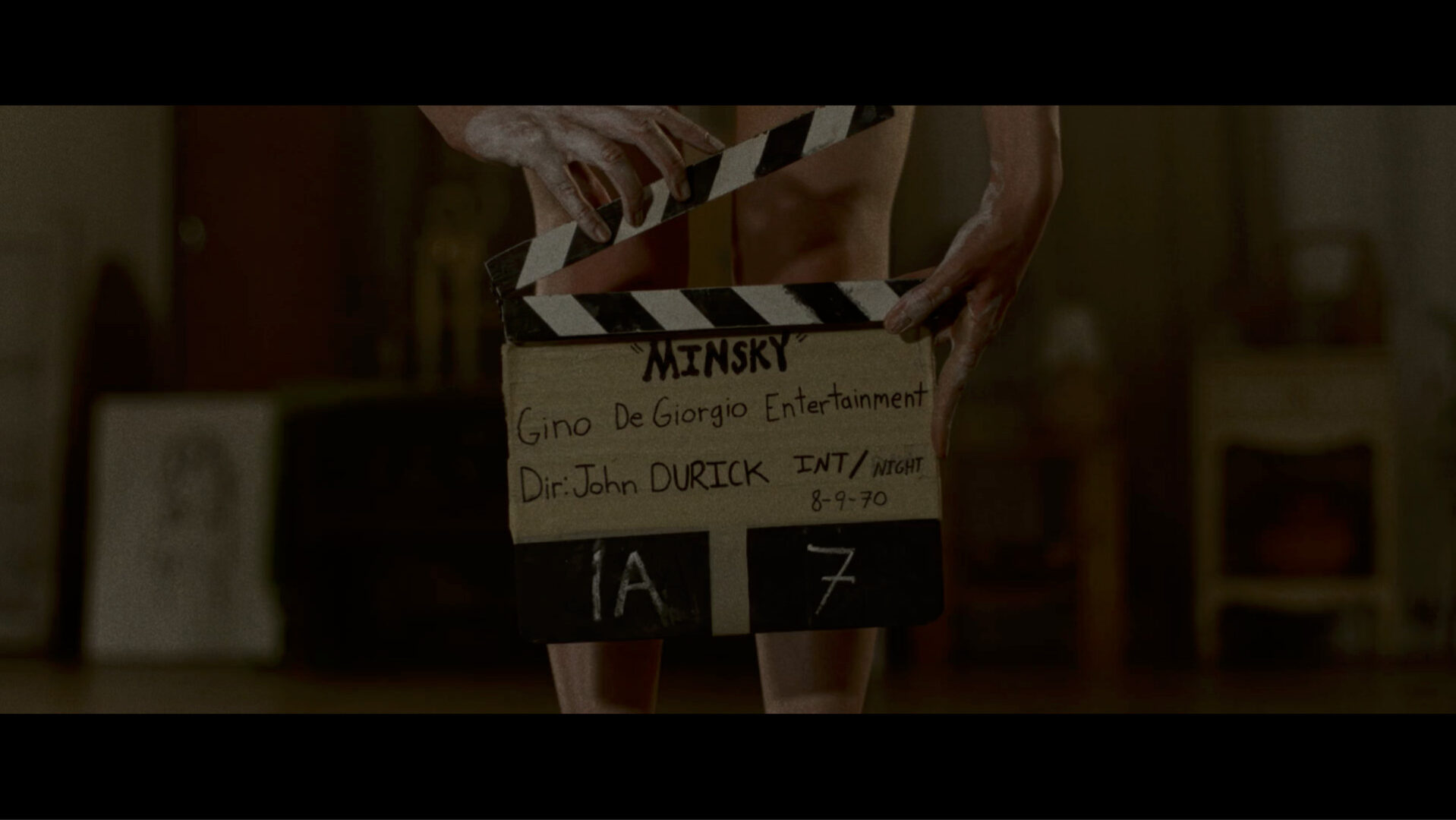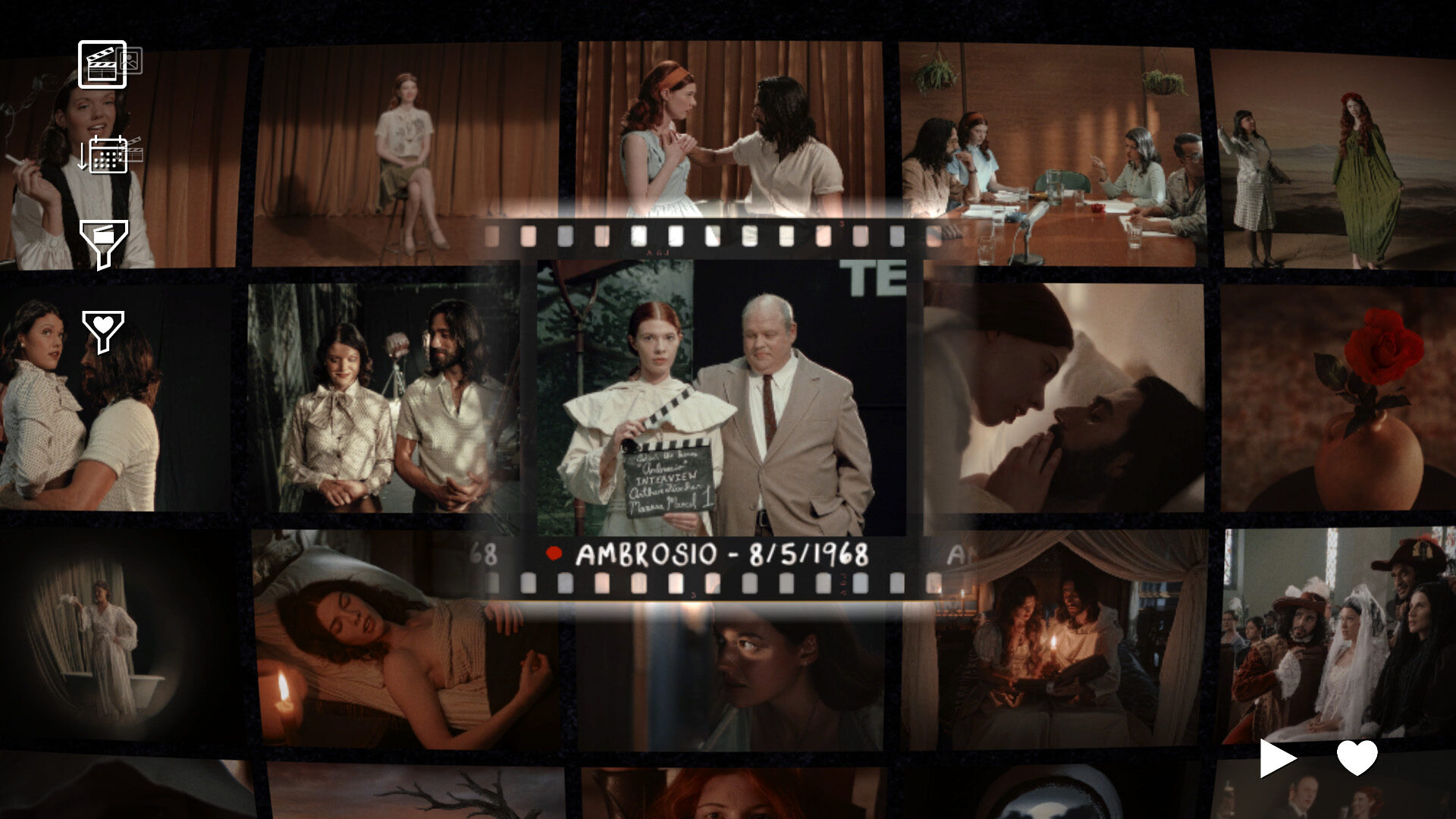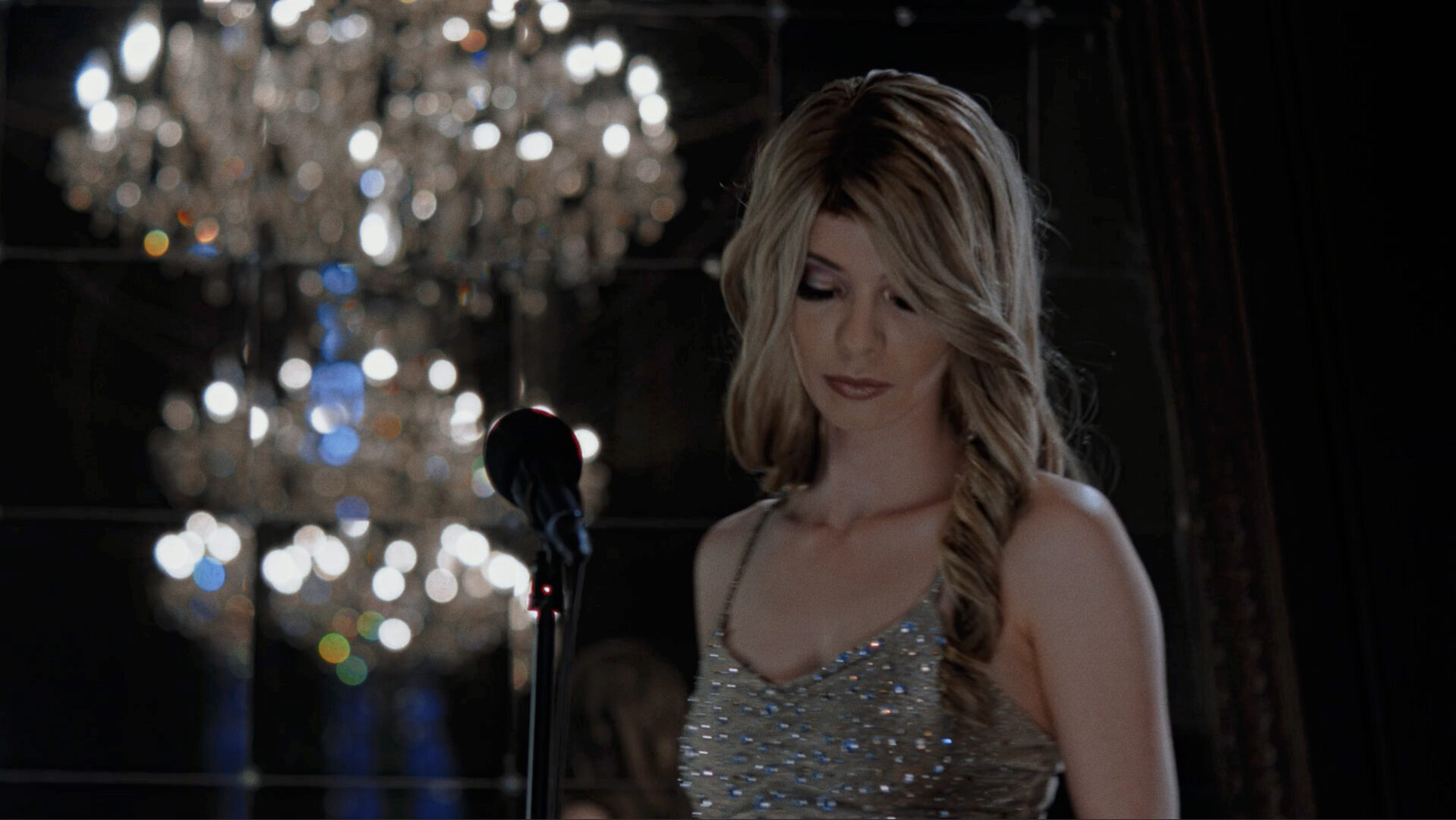With Immortality, Her Story and Telling Lies creator Sam Barlow turns his now-trademark found footage style on its head. As in his previous games, you start with a limited understanding of who and what you’re watching, and the only way to learn more is to find linkages between FMV clips, building up a bigger and bigger library along the way. But in expanding the scope of his storytelling and making some fundamental tweaks to how you navigate the narrative, Barlow has ensured Immortality doesn’t feel like a retread—even if not every ambitious gamble pays off.
This time, the clips you’re uncovering tell the story of Marissa Marcel, a young actress plucked from obscurity to star in Ambrosio, a (fictional) 1968 adaption of the (real) 1796 novel The Monk, about the corruption of a priest during the Spanish Inquisition. But the film never actually saw release, and neither did the other two movies Marcel starred in: Minsky, a 1970 New Hollywood detective story set in the New York City art world, and Two of Everything, a glossy 1999 thriller about a pop star and her body double.
Even here, at the most straightforward level, it’s hard to overstate how much artistry Barlow and his team have poured into Immortality. Everything—the film grain, the production techniques, the acting styles, the writing—reflects a spot-on interpretation of these different eras in filmmaking without ever descending into cheap parody. The theatrical sets and gorgeous matte paintings of Ambrosio give it an identity wholly apart from the grimy New York location shooting of Minsky. If you edited trailers for these films together and threw them up on YouTube, I bet you could fool quite a few people into thinking they were real. They’re not great cinema, of course, but they’re entirely plausible as movies from their respective eras that you’ve never heard of.

What’s truly fascinating about Immortality’s approach to narrative, though, is that the framework of three movies is simply a jumping off point, the top layer of what’s really going on in this mystery. The footage you find is all tied to the films—uncut takes, rehearsals, location-scouting shoots, making-of interviews, cast parties, and so on—but the real meat of the story exists outside the frame of the movie screen: the moments after the director yells cut, flubbed lines, footage that was always meant for the cutting room floor.
This approach, of fake-real narratives clustered around fake-fake narratives, of art interrogating art, of real people playing fake people playing fake people, could easily descend into an overly philosophical, navel-gazing blob. But it never does. That’s to the credit of Barlow and his writing team—Alan Scott, Amelia Gray, and Barry Gifford—but also to the performers. Manon Gage, in particular, does such a phenomenal job of imbuing Marissa with all the depth and variation the character demands that I was shocked to learn that this is her first major role.
But if Immortality benefits from a more maximalist approach to narrative, in gameplay (if that’s even the right word) Barlow’s evolution is much less straightforward. Whereas Her Story and Telling Lies both used language as the connective tissue you traced to uncover their stories—unlocking new clips by searching carefully chosen keywords—Immortality spins a web that’s entirely visual. At any point while watching any clip, you can pause it and pass a cursor over everything you see. Objects and faces in the scene become hyperlinks, allowing you to “match cut” to a different piece of footage that also features that person or object.
The big limitation in Her Story and Telling Lies—the challenge, if you will—was specificity. You were always struggling to puzzle out the right word that might open up a new line of inquiry. You could only view so many results for each search, so you couldn’t brute force everything by searching for incredibly common words. You needed to constantly reassess your understanding of the story, because if you weren’t following along, you could never advance. You’d never find the specific word needed to get to a new clip and generate new leads.
In Immortality, specificity is impossible. Each cut leads you directly to one other scene, not to a list of options. You have no way of guessing where you’ll end up in advance. All you can know for certain when you click a flower is that you’ll go to a scene with another flower (or at least something flower shaped). Any logic underlying the connections is entirely opaque. The game certainly isn’t always finding the best match cut. Clicking someone’s face in profile may lead you to a shot where they’re facing the camera, and a half-focused leaf in the background might take you to a clip of a very different-looking plant in the center of the frame.

What’s more, you can immediately click on the same object in the new scene and jump to a different scene, over and over, adding more clips to your library without ever actually watching any of them. Playing this way, you’ll likely loop back to a scene you’ve already visited, but it’s not a closed circle. Clicking the exact same object on the exact same frame can take you to multiple different scenes, seemingly at random. I don’t think it’s possible to collect a full set of clips featuring any one object or person this way—some things are trapped down one-way streets, I suspect, to make sure you’re not just hammering buttons. But without any transparency in how the connections work, there’s little room for strategy.
The result of all this, at least in my experience, is that playing Immortality isn’t about moving through a story in a nonlinear fashion so much as confusedly, recklessly spiraling around inside it. Playing Her Story for the first time, I felt like a detective. Playing Telling Lies, I felt like both a detective and a spy. Playing Immortality, I felt like a chimpanzee with a vacuum cleaner. Rather than paying attention to each scene in full and trying to reason out my next lead, I just clicked on any object or face that seemed new or intriguing as soon as it appeared, hoovering up scene after scene for my collection. Piecing together the story, I figured, would come later.
But it didn’t quite work out like that. Instead, I kept getting achievement pop ups telling me I had discovered the fate of some character before I had even bothered to learn their name. Shockingly soon, I had an answer to the game’s central question: What happened to Marissa Marcel?
Well, I should say, I had one answer to that question. Like Barlow’s previous work, there’s a deeper layer to everything in Immortality that you need to put in a bit of intentional work to discover. I won’t say too much and risk spoiling the best (and perhaps only) surprise the gameplay has to offer. But I will note that this layer of the game suffers from repetition and a lack of interconnectedness that render it inelegant, even as it delivers eerie surprises and a show-stopping climax. While it demands a deeper level of engagement than the shotgun-blasting of the match cuts, it stills feels very much, by necessity, like a brute force exercise. I still got to the credit roll with only the vaguest sense of who characters were and what had happened to them, and basically no sense that I’d earned my progress.

I actually remember asking Sam Barlow about this exact possibility during an interview about Telling Lies. What happens if, through blind luck, a player immediately searches for the right keyword and jumps straight to a clip that explains the game’s central mystery? As I recall, Barlow told me that the idea didn’t bother him much, because he doesn’t write whodunits so much as whydunits, stories in which a web of characters and motivations is just as important as the “answer” to the plot.
With Immortality, I found myself living out the reality of that hypothetical. I assembled the most hidden, mysterious pieces of the puzzle first, then gradually grasped the stories of the “real” people—the fictional actors and directors making the movies—and then finally understood the plots of the movies themselves. I wasn’t digging deeper; I was clawing my way out. There was still something worthwhile in the outer layers, elements that enriched and contextualized what I’d already discovered, but not enough to fend off anticlimax. Filling in the gaps was like watching a movie in reverse, or reading a novel with all the exposition cut out and glued into the last hundred pages.
I know I’m to blame, but I don’t think I’m exclusively to blame. I keep coming back to the looseness of the match-cut system, to the misaligned incentives it creates. A well-designed game teaches you how to play it, not just literally but philosophically. Immortality never showed my min-maxing gamer brain a better way to engage until it was already too late.
I’m struggling a bit with my own argument, because I understand that many of the traits I find lacking in Immortality’s interactivity reflect themes in its story: the flattening of time, the lack of fixed meaning in images, the struggle to communicate through art. I can appreciate that Barlow thought hard about the limitations of his central mechanic and built a narrative that both complements and interrogates it. But at the risk of going all Ambrosio on you, confession isn’t the same thing as absolution, not exactly.
Of course, I’m well aware that a critique like this is itself testament to the ambition of the work. The vast majority of modern games can’t fail in thought-provoking ways because they play it safe with conservative, recycled designs. Though a successor to Her Story and Telling Lies, Immortality is still radically new. Even when Barlow missteps, he’s stumbling into interesting territory.
The highest compliment and the harshest criticism I can offer, then, are actually the same: Immortality is thrilling and imperfect, fascinating and messy—but it certainly isn’t boring.
|
★★★★☆
Immortality finds creator Sam Barlow building on the found-footage FMV framework of Her Story and Telling Lies in ambitious and surprising new ways. That boldness pays off in the frame-shifting narrative, which encompasses three meticulously crafted feature films, their creation, and the sinister truth of what happened to the woman who starred in them. But the “match cut” system you use to navigate between clips and discover new ones means the actual process of piecing together the story is messier and less satisfying than in his previous work. |
Developer Sam Barlow, Half Mermaid Publisher Half Mermaid ESRB M - Mature Release Date 08.30.2022 |
| Immortality is available on Xbox Series X/S, PC, Mac, iOS, Android. Primary version played was for Xbox Series X. Product was provided by Half Mermaid for the benefit of this coverage. EGM reviews on a scale of one to five stars. | |
